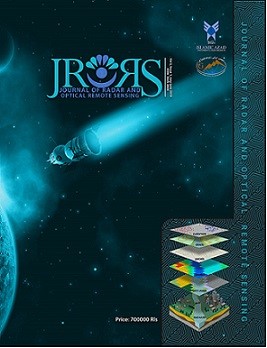Evaluation of super-resolution algorithm for detection and recognition of features from MODIS and OLI images at sub-pixel scale using Hopfield Neural Network
محورهای موضوعی : فصلنامه علمی پژوهشی سنجش از دور راداری و نوری و سیستم اطلاعات جغرافیاییMohammad Hosein Mehrzade Abarghooee 1 , Ali Sarkargar Ardakani 2
1 - Ms in GIS&RS,Yazd Branch, Islamic Azad University, Yazd, Iran
2 - GIS&RS Department, Yazd Branch, Islamic Azad University, yazd, Iran
کلید واژه: Super resolution, Land cover, Fuzzy classification, Hopfield Neural Network, Spatial resolution, Subpixel, Energy function,
چکیده مقاله :
Fuzzy classification techniques have been developed recently to estimate the classcomposition of image pixels, but their output provides no indication of how theseclasses are distributed spatially within the instantaneous field of view represented bythe pixel. Super-resolution land-cover mapping is a promising technology forprediction of the spatial distribution of each land-cover class at the sub-pixel scale.This distribution is often determined based on the principle of spatial dependence andfrom land-cover fraction images derived with soft classification technology. As such,while the accuracy of land cover target identification has been improved using fuzzyclassification, it remains for robust techniques that provide better spatial representationof land cover to be developed. An approach was adopted that used the output from afuzzy classification to constrain a Hopfield neural network formulated as an energyminimization tool. The network converges to a minimum of an energy function. Thisenergy minimum represents a “best guess” map of the spatial distribution of classcomponents in each pixel. The technique was applied to remote sensing imagery(MODIS & OLI images), and the resultant maps provided an accurate and improvedrepresentation of the land covers. Low RMSE, high accuracy. By using a Hopfieldneural network, more accurate measures of land cover targets can be obtained, The Hopfield neural network used in this way represents a simple, robust, and efficienttechnique, and results suggest that it is a useful tool for identifying land cover targetsfrom remotely sensed imagery at the sub-pixel scale. The present research purpose wasevaluation of HNN algorithm efficiency for different land covers (Land, Water,Agriculture land and Vegetation) through Area Error Proportion, RMSE andCorrelation coefficient parameters on MODIS & OLI images and related ranking,results of present super resolution algorithm has shown that according to precedence,most improvement in feature’s recognition happened for Water, Land, Agricultureland and ad last Vegetation with RMSEs 0.044, 0.072, 0.1 and 0.108.
Fuzzy classification techniques have been developed recently to estimate the class composition of image pixels, but their output provides no indication of how these classes are distributed spatially within the instantaneous field of view represented by thepixel.This distribution is often determined based on the principle of spatial dependence and from land-cover fraction images derived with soft classification technology. An approach was adopted that used the output from a fuzzy classification to constrain a Hopfield neural network formulated as an energy minimization tool. The network converges to a minimum of an energy function. energy minimum represents a “best guess” map of the spatial distribution of class components in each pixel. The technique was applied to remote sensing imagery and the resultant maps provided an accurate and improved representation of the land covers. Low RMSE, high accuracy By using a Hopfield neural network, more accurate measures of land cover targets can be obtained, The Hopfield neural network used in this way represents a simple, robust, and efficient technique, and results suggest that it is a useful tool for identifying land cover targets from remotely sensed imagery at the subpixel scale. The present research purpose was evaluation of HNN algorithm efficiency for different land covers (Land, Water, Agricultured land and Vegetation) on MODIS & OLI images and related ranking, results of present super resolution algorithm has shown that according to precedence, most improvement in feature’s recognition happened for Water, Land, Agricultured land and ad last Vegetation with RMSEs 0.044, 0.072, 0.1 and 0.108.


